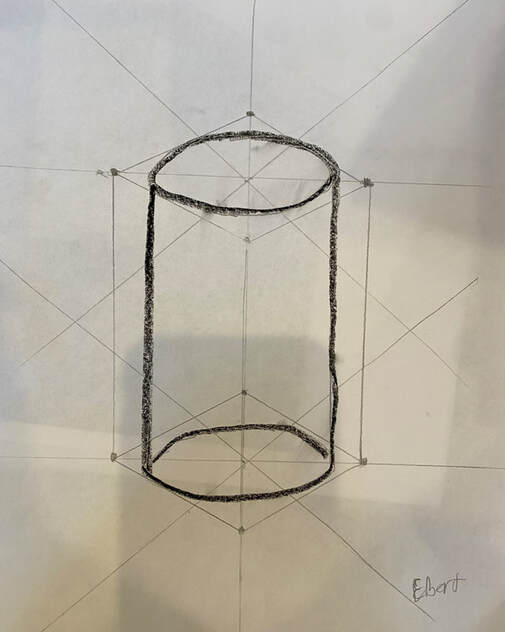Student's artworks by Elbert & Sophia Today, I would like to show you a drawing by 10-year-old artists, Albert and Sofia. We moved from rectangular poles to cylinders today. "Everything in nature is made up of spheres, cones and cylinders. We must learn to paint with these simple shapes." This is a story told by my favorite painter,Paul Cézanne. He is often credited with paving the way for the development of modern art in the 20th century, especially with his use of geometric shapes and his exploration of the relationship between form and color. Cézanne was born in Aix-en-Provence, France, and began his artistic studies in the 1850s at the Académie Suisse in Paris. He was heavily influenced by the Impressionists, but he ultimately rejected their emphasis on fleeting moments and fleeting sensations in favor of a more structured approach to painting. Cézanne's early works were often still lifes and landscapes, but he later began to paint figures, particularly bathers, in his signature style. He was known for his use of color, which he used to create depth and to suggest volume and form. He also experimented with perspective, often depicting objects from multiple angles in the same painting. He was not widely recognized during his lifetime, and he struggled financially throughout his career. However, his work gained critical acclaim after his death, and he is now widely regarded as one of the most important artists of the 19th century. His influence can be seen in the work of many modern artists, including Pablo Picasso and Georges Braque. He thought that while Impressionist painters at that time focused on the beauty of objects reflected in the light every moment, he thought that the beauty of objects was inside. So he focused more on the essential structure of the object being drawn. I consider Cézanne to be my spiritual mentor because of this aspect. I also want to explore the intrinsic beauty of things. Cézanne was a 19th-century painter, but his painting style and this philosophy eventually had a great influence until after the 20th century. I also think that you need to know the fundamental structure of things first. In this sense, my classes contain basic shapes such as circles, cones, and cylinders. After exploring the nature of these shapes, we will learn more about the world of color, light and shade, mass and composition. In this sense, it is important to teach children how to observe and draw shapes. In Elbert's case, he developed his own method and drew the cylinder perfectly. While thinking this way, children can observe and remember models of objects that change depending on the viewing angle, and explore how to represent them. Below is a picture of the texture expressed by Elbert and Sophia. To make a patchwork style t-shirt, the children tried various things. When they made this T-shirt, they showed the best concentration, and the children even hummed. In other words, they know the joy of exploring, applying, and creatively experimenting with materials in painting. I think children are natural- born artists. And below is an illustration of a circus expressed by children with their own imagination. All of them have fond memories of the circus and show signs of trying to draw and express this joy and wonder. The exploration of the materials above is followed by the circus picture below. Creating a circus painting with mixed media can have several benefits. -Firstly, mixed media allows for a wide range of materials and techniques to be used, which can add texture, depth, and complexity to the artwork. For example, an artist can use collage techniques to add layers of paper or fabric to the canvas, or they can use different types of paint, such as acrylic and oil, to create contrasting effects. This can make the painting more visually interesting and dynamic. -Secondly, creating a circus painting can be a fun and creative way to explore the vibrant and colorful world of the circus. The subject matter can be playful and whimsical, which can be a refreshing change from more serious or abstract art. Children will be able to learn how to express richly according to each theme in the next step.
0 Comments
Leave a Reply. |
Myungja Anna KohArtist Categories
All
Archives
July 2024
|
Proudly powered by Weebly








 RSS Feed
RSS Feed